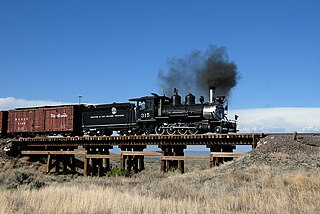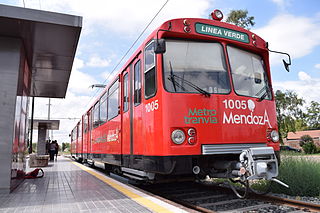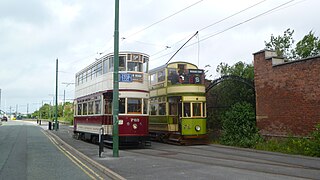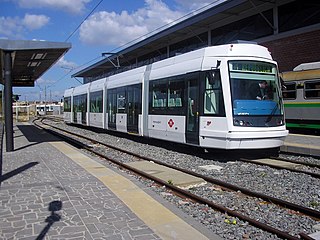
A tram is a type of urban rail transit. It consists of a rail vehicle, either alone or coupled in a multiple train unit, traveling on tramway tracks on public urban streets; some include segments on segregated right-of-way. The tramlines or networks operated as public transport are called tramways or simply trams/streetcars. Many recently built tramways use the contemporary term light rail.

Light rail transit (LRT) is a form of passenger urban rail transit characterized by a combination of tram and rapid transit features. While its rolling stock is similar to that of a traditional tram, it operates at a higher capacity and speed and often on an exclusive right-of-way. In many cities, light rail transit systems more closely resemble, and are therefore indistinguishable from, traditional underground or at-grade subways and heavy-rail metros.

Manchester Metrolink is a tram/light rail system in Greater Manchester, England. The network has 99 stops along 64 miles (103 km) of standard-gauge route, making it the most extensive light rail system in the United Kingdom. Metrolink is owned by the public body Transport for Greater Manchester (TfGM) and operated and maintained under contract by a Keolis/Amey consortium. Over the 2022/23 financial year 36 million passenger journeys were made on the system.

The Sheffield Supertram is a tram and tram-train network covering Sheffield and Rotherham in South Yorkshire, England. The infrastructure is owned by the South Yorkshire Passenger Transport Executive (SYPTE), with Stagecoach responsible for the operation and maintenance of rolling stock under a concession until 2024, under the brand name Stagecoach Supertram.

Nottingham Express Transit (NET) is a 20-mile (32 km) tram system in Nottingham, England. The system opened to the public on 9 March 2004 and a second phase, that more than doubled the size of the total system, opened on 25 August 2015, having been initially planned to open two years earlier.

Conservation and restoration of rail vehicles aims to preserve historic rail vehicles.

Metro is the passenger information brand used by the West Yorkshire Combined Authority in England. It was formed on 1 April 1974 as the West Yorkshire Passenger Transport Executive (WYPTE), at the same time as the metropolitan county of West Yorkshire. The Metro brand has been used from the outset and, since the formal abolition of the WYPTE on 1 April 2014, it has remained the brand name of public transport in the region, overseen by the West Yorkshire Combined Authority, which is also responsible for the delivery of transport policies.

Transport in Sheffield, England is developed around the city's unusual topography and medieval street plan. Once an isolated town, the transport infrastructure changed dramatically in the 19th and 20th centuries. The city now has road and rail links with the rest of the country, and road, bus and trams for local transport.

Doncaster Corporation Tramways was an electric tramway network serving the town of Doncaster, England. It was authorised in 1899, and the first route to Bentley opened in 1902. This remained separated from the rest of the system until North Bridge was built to carry traffic over the Great Northern Railway main line to Edinburgh. Soon afterwards, deep mining of coal began in the area, and several extensions to the system were made between 1913 and 1916 to serve new communities which developed around the pit heads. The Racecourse route was unusual, in that it had balloon loops at both ends to enable almost continuous running on race days, a feature that was not common in England, and only found favour in Europe in the 1950s and 1960s.
The Mexborough and Swinton Traction Company was the name adopted by the Mexborough & Swinton Tramways Company in 1929 following the introduction of trolleybuses on all its routes. It operated in the West Riding of Yorkshire, England, over routes serving Manvers Main Colliery, Wath upon Dearne and the towns of Rotherham, Rawmarsh, Swinton, Mexborough, Conisbrough and the estate at Conanby.

A rubber-tyred tram is a development of the guided bus in which a vehicle is guided by a fixed rail in the road surface and draws current from overhead electric wires.

The Metrotranvía Mendoza is a public light rail transport system for the city of Mendoza, Argentina, served by articulated light rail cars operating on newly relaid tracks in former-General San Martín Railway mainline right-of-way.

Between 1901 and 1949 Manchester Corporation Tramways was the municipal operator of electric tram services in Manchester, England. At its peak in 1928, the organisation carried 328 million passengers on 953 trams, via 46 routes, along 292 miles (470 km) of track.

The history of Manchester Metrolink begins with its conception as Greater Manchester's light rail system in 1982 by the Greater Manchester Passenger Transport Executive, and spans its inauguration in 1992 and the successive phases of expansion.

Wirral Tramway is a heritage tramway opened in 1995 by the Wirral Borough Council and Hamilton Quarter partnership and was operated by Blackpool Transport Services until 2005 when the council took over the licence to run the tramway.
The CAF Urbos is a family of trams, streetcars, and light rail vehicles built by CAF. The Spanish manufacturer CAF previously made locomotives, passenger cars, regional, and underground trains. In 1993, CAF started building trams for Metrovalencia, with the delivery of 16 trams until 1999. This was a variant of a Siemens design and some components were delivered by Siemens, including bogies and traction motors. This design was also sold to Lisbon Trams in 1995; CAF then decided to design and build the Urbos in-house.

Trams in England encompass various tram networks integrated into the public transport system of England. Until 1935, there had been a large and comprehensive network of tram systems in towns and cities.

The Cagliari light rail system, commercially known as Metrocagliari, is a two-line light rail system that serves the town of Cagliari and part of its metropolitan area, in Sardinia, Italy. The system was inaugurated in 2008 and has subsequently been expanded to two lines.
Bradford Corporation Tramways were a tramway network in the city of Bradford, West Riding of Yorkshire, England which operated trams from 1882 until 1950 and trolleybuses from 1911 until 1972. The track gauge of the tramways was 4 ft.


















